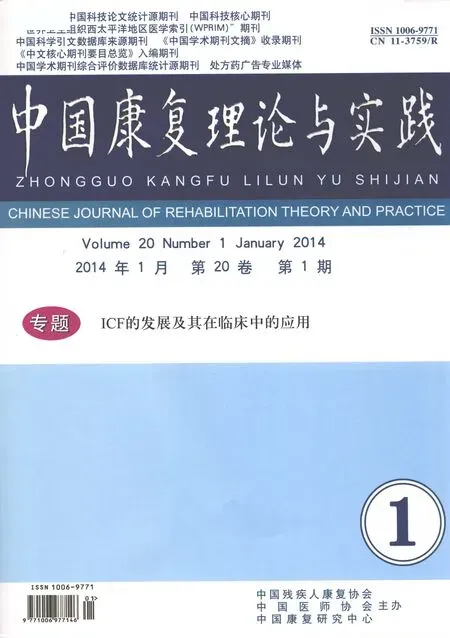运动功能与脑缺血后锥体束重塑的关系①
张婵娟,温红梅
运动功能与脑缺血后锥体束重塑的关系①
张婵娟,温红梅
运动功能障碍是脑梗死后主要的问题之一。皮质梗死部位和梗死体积对运动功能的影响不大,而白质通路,特别是锥体束损伤对运动功能有重要影响。运动功能恢复与梗死灶对侧皮质神经通路的重塑密切相关;健侧锥体束轴突出芽并生长至对侧白质可促进脑缺血后运动功能恢复。运动训练及其他康复因子可对脑缺血后锥体束神经纤维重塑发挥作用。
脑缺血;锥体束;运动功能;康复;综述
[本文著录格式]张婵娟,温红梅.运动功能与脑缺血后锥体束重塑的关系[J].中国康复理论与实践,2014,20(1):49-52.
1 脑缺血后的锥体束损伤与运动功能障碍
脑白质几乎占成人脑体积的一半,连接皮质、皮质下结构和相关功能脑区,构成完整的神经网络。其中锥体束起于大脑皮质锥体细胞,在离开大脑皮质之后,行经内囊后部、大脑脚中部、脑桥基底部至延髓锥体;在其后部大部分纤维进行交叉,称为皮质脊髓外侧束,在脊髓白质外侧索下行,可达脊髓末端;部分纤维不交叉,称为皮质脊髓腹侧束,在同侧脊髓白质腹侧索下行,仅达脊髓颈部和上胸部。锥体束主要传导、启动与控制随意运动,尤其是精细运动的神经冲动,管理躯干和四肢骨骼肌的随意运动,特别是四肢远端的精细活动。
脑缺血后,脑白质神经纤维密度下降,髓鞘脱失,出现轴突损伤甚至变性、死亡,星形胶质细胞增生、肿胀、突起瓦解,小胶质细胞激活。锥体束轴突和髓鞘病变影响其信号传导功能,导致各功能区联络中断,产生神经功能障碍。脑梗死后锥体束损伤有两种:病灶内直接的轴突破坏和病灶周围乃至远隔区域继发性沃勒变性(近端轴突或细胞体损伤后,远端轴突及髓鞘层的退行性改变)[1-2]。
脑缺血慢性期皮质梗死体积对运动功能影响并不大,随着时间的推移,这种影响更加微弱[3]。脑缺血后神经功能的缺失常常是因为轴突联系的阻断,而不是细胞的凋亡[4]。大量髓鞘缺失,以及内源性轴突生长抑制因子导致轴突生长受限,均是脑缺血后神经功能缺失持续存在的重要因素。脑梗死急性期及慢性期的运动功能障碍均伴有下行锥体束的沃勒变性,锥体束沃勒变性范围越大,运动的力量、灵活度、活动范围越差[2,5]。脑梗死后运动功能障碍与白质通路损伤而非皮质梗死灶关系更加密切:单侧大脑梗死后下行锥体束结构完整性越差,梗死灶对侧肢体运动越差。皮质下的纤维束结构和功能完整性的破坏是脑卒中后肢体功能障碍的主要原因之一。
2 脑缺血后锥体束重塑与运动功能恢复
正常成年人的白质结构并非一成不变。在学习复杂或新的技能,如弹钢琴、阅读后,相应功能区的脑白质结构出现明显的变化,表现为体积、组织结构、功能连接等增加,可称之为脑白质重塑[6]。
既往大量研究显示[7-9],促进轴突结构重塑的方法有助于神经受损后运动功能的恢复。促红细胞生成素等药物干预促进脑梗死后功能恢复,依赖锥体束的结构可塑性[9];强制性运动训练可通过抑制内源性抑制因子,促进轴突再生及突触可塑性,改善脑缺血后受损的运动功能[7];上肢技巧性运动功能的恢复与健侧运动皮质生长至梗死侧皮质下运动区域的新生轴突数目密切相关[10]。由此可见,皮质脊髓束的结构完整是运动功能恢复的决定性因素,促进锥体束结构可塑性的治疗方案可以提高康复潜能。同样,通过测量锥体纤维束结构完整性也可预测脑梗死后功能恢复情况[11]。
脑缺血后的锥体轴突反应可表现为以下几种形式[4]。最简单的生长方式是从已离断的轴突延伸;此外,受损轴突可从近端发出侧支,或在与离断通路临近或伴行神经纤维系统轴突生长。在没有干预因素的情况下,哺乳动物中枢神经系统的轴突生长很少超过1 mm;当治疗性干预介入后,轴突可以形成新的通路。
在脑缺血后,中枢神经系统具有较强的可塑性。单侧大脑半球脑梗死后,梗死周围的皮质结构发生改变,与梗死侧皮质下结构的联系减少;梗死侧大脑皮质所对应的镜像区域,即健侧大脑皮质与梗死灶侧功能相似区域也发生结构改变:健侧大脑皮质下行锥体束发出轴突至梗死侧皮质下结构,既可形成新的短距离神经通路,也可发出长轴突至患侧红核以及患侧颈髓平面,形成长距离的神经通路[12-15]。
相比患侧,健侧皮质锥体束结构重塑可能更有促进脑缺血后神经功能恢复的潜能。健侧锥体束的结构完整与脑缺血后功能恢复相关,并可能是预测脑卒中慢性期功能恢复水平的重要指标[16]。此外,海马在脑缺血后同样具有结构可塑性。脑缺血后相对短的时间内,对侧海马的轴突出芽形成新的通路,以替代脑缺血后退化的轴突。在1个月内,对侧海马发出轴突终末分支,并在局部形成新的突触,代替已经消亡的突触。在海马内,树突可以接受病灶侧皮质和健侧海马的神经冲动[14]。
脑梗死患者自发性功能恢复至少部分归因于锥体束系统的结构重塑[17]。Brown的研究指出,在大脑皮质梗死后,缺血病灶周围可出现明显的树突棘长度增加[18]。这种自发性轴突再生只存在于小面积梗死灶周围。锥体束受损后自发性的功能恢复取决于受累部位,锥体束的背侧、腹侧束受损后自发性功能恢复受限,可产生严重而持久的运动功能缺失[19]。脑缺血后常常导致进展性、不可逆的功能缺失,表明成年哺乳动物中枢神经系统受损后再生能力及解剖结构重塑能力非常有限。自发性功能恢复最有可能是由备用神经通路的出芽或者代偿产生,这种自发性的功能恢复可被治疗性干预进一步加强[20]。
3 康复干预对锥体束重塑和运动功能恢复的影响
3.1 运动训练
中枢神经系统的突触联系在发育中形成,并在活动中被改变,轴突再生也可被运动诱导[4,20]。研究显示,运动训练可以促进神经可塑性并提高运动功能[21-22]。运动训练可以促进缺血损伤后健侧皮质自发性产生的少量树突状结构进一步增多。在运动学习中,运动皮质可出现新的突触发生[23]。目前在动物实验中采用的训练方式主要有三类,跑步训练、丰富环境、前肢技巧性运动训练。这三种运动训练对于脑缺血后锥体束生长的影响不尽相同。
跑步训练可以增强脑缺血后突触可塑性,提高运动学习能力,可能与跑步训练后健侧大脑半球脑源神经营养因子(BDNF)、突触蛋白Ⅰ水平上升有关[23]。BDNF可影响中枢神经轴突可塑性和出芽[24],但具体机制尚不明确。有学者认为,BDNF可通过调节海马区域的突触蛋白Ⅰ的表达,间接影响海马的突触可塑性[25]。此外,跑步训练可促进脊髓损伤后功能更快恢复,其机制可能是跑步训练促进了皮质脊髓束的可塑性改变,通过促进轴突出芽或者突触的可塑性,强化下行通路联系[26]。Ying的实验指出,跑步训练可提高脊髓损伤大鼠颈膨大BDNF、突触蛋白Ⅰ水平,从而促进颈膨大突触可塑性及运动功能的恢复[27]。
既往实验研究显示,处于丰富环境中的正常成年动物神经元树突分支、树突棘及突触数目较单独饲养或普通饲养的动物增加,丰富环境可增加缺血后皮质树突棘突数目,改变棘突形态[28];并可促进健侧皮质发出长轴突到脊髓,提高患侧前肢的技巧性运动功能[29]。可能是因为丰富环境强化了学习诱导的结构可塑性,但是具体机制尚不十分明确。丰富环境可产生神经生长因子的内在改变,如神经生长因子(NGF)、脑源性神经生长因子,影响神经可塑性。研究证明,NGF可促进运动功能及认知功能恢复,减轻健存锥体细胞树突萎缩[30-31]。丰富环境可能是通过促进NGF的表达,影响轴突再生从而促进运动功能及认知功能的提高[31]。
前肢技巧性运动训练可诱发运动学习相关的树突和突触改变。患侧前肢的运动训练可使梗死灶周围产生新的树突生长,促进神经可塑性,进而影响运动皮质神经通路功能联系。集中于损伤前肢的运动训练除了可促进梗死部位附近区域的结构可塑性,还可直接增加健侧运动皮质新生树枝状分支数目;而这种树突的改变可形成新的突触联系或者激发潜在通路,并且增多的树突可能是促进突触生长的前提[22]。大鼠在学习技巧性取食的后期,皮质中突触数目增多[32]。患侧前肢强制性使用训练可以促进脊髓灰质跨中线神经纤维的生长,还可以促进突触的形成[7];当禁用患侧前肢时,锥体束终末端轴突的形态受到影响,运动功能也随之减退[33]。
3.2 运动训练结合药物干预
运动训练可以增强某些药物干预的作用[34]。例如,苯异丙胺可促进脑缺血后大鼠轴突再生及运动功能恢复,运动训练可增强苯异丙胺这一作用。运动训练结合黄体酮治疗较单一治疗更能促进脑缺血动物功能的恢复[35]。但是,并非所有药物干预结合运动训练都可以提高治疗效果,运动训练和某些药物干预治疗既有联系又存在着区别[36]。Po在Nogo-A及Nogo-A受体(NgR1)对中枢神经长距离轴突生长影响的实验中发现,纤维生长与受损前肢的精细技巧性运动功能的恢复相关;抑制Nogo-A或NgR1表达,可出现跨脊髓中线生长的锥体束出芽[37]。运动训练也可使受损前肢的精细技巧性运动功能的恢复。由此推测,运动训练至少部分是通过抑制Nogo-A通路及其他神经抑制因子,促进脑缺血后锥体束结构重塑[7]。但既往研究提示,对脊髓损伤大鼠单独予以Nogo-A拮抗剂干预或运动训练均可促进运动功能的恢复,但是联合运用这两种干预方式并没有增强疗效[36],可能是因为运动训练和Nogo-A拮抗剂对于促进脊髓损伤后功能恢复所发挥作用的机制不同,也可能与运动训练的强度有关。如何综合运用药物和运动训练,更好地促进缺血后锥体束生长,需要更多的实验研究进一步揭示。
3.3 其他干预方法
对脑梗死模型大鼠予肌酐联合应用NEP1-40(Nogo受体拮抗剂)或者丰富环境训练综合治疗,可使从健侧出芽至患侧皮质脊髓束轴突分支数量显著增加,同时大鼠技巧性运动功能水平明显提高[38]。动物实验中,单克隆抗体IN-1或其他Nogo-A拮抗剂均可以促进脑梗死后神经可塑性或者神经生长至对侧的去神经支配区域,并伴功能恢复[39]。脑缺血后,经尾静脉注射骨髓间充质细胞[40],经皮质注射神经干细胞[12]、血管内皮生长因子[13],均可以促进健侧皮质发出长轴突至颈髓平面,尤其是支配上肢运动的C4~C6平面[40]。
4 展望
运动训练可以促进梗死周围的树突结构可塑性,也可促进健侧运动皮质运动神经元产生新的树枝状分支,发出长轴突到达颈髓平面。不同的运动训练对功能恢复的神经生理机制不尽相同,是否对脑缺血后锥体束结构重塑影响也存在差异?如何制定最佳运动方案以最大程度地促进脑缺血后锥体束结构重塑?这些都需要进一步研究揭示。
[1]Wang F,Liang Z,Hou Q,et al.Nogo-A is involved in secondary axonal degeneration of thalamus in hypertensive rats with focal cortical infarction[J].Neurosci Lett,2007,417(3): 255-260.
[2]Lindberg PG,Skejø PH,Rounis E,et al.Wallerian degeneration of the corticofugal tracts in chronic stroke:a pilot study relating diffusion tensor imaging,transcranial magnetic stimulation,and hand function[J].Neurorehabil Neural Repair,2007, 21(6):551-560.
[3]Mark VW,Taub E,Perkins C,et al.MRI infarction load and CI therapy outcomes for chronic post-stroke hemiparesis[J].Restor Neurol Neurosci,2008,26(1):13-33.
[4]Cafferty WB,McGee AW,Strittmatter SM,et al.Axonal growth therapeutics:regeneration or sprouting or plasticity?[J].Trends Neurosci,2008,31(5):215-220.
[5]Domi T,de Veber G,Shroff M,et al.Corticospinal tract pre-Wallerian degeneration:a novel outcome predictor for pediatric stroke on acute MRI[J].Stroke,2009,40(3):780-787.
[6]Fields RD.Change in the brain's white matter[J].Science, 2010,768(330):9.
[7]Zhao S,Zhao M,Xiao T,et al.Constraint-induced movement therapy overcomes the intrinsic axonal growth-inhibitory signals in stroke rats[J].Stroke,2013,44(6):1698-1705.
[8]Benowitz LI,Carmichael ST.Promoting axonal rewiring to improve outcome after stroke[J].Neurobiol Dis,2010,37(2): 259-266.
[9]Reitmeir R,Kilic E,Kilic U,et al.Post-acute delivery of eryth
ropoietin induces stroke recovery by promoting perilesional tissue remodelling and contralesional pyramidal tract plasticity[J].Brain,2011,134(1):84-99.
[10]Seymour AB,Andrews EM,Tsai SY,et al.Delayed treatment with monoclonal antibody IN-1 1 week after stroke results in recovery of function and corticorubral plasticity in adult rats[J].J Cereb Blood Flow Metab,2005,25(10):1366-1375.
[11]Sterr A,Shen S,Szameitat AJ,et al.The role of corticospinal tract damage in chronic motor recovery and neurorehabilitation:a pilot study[J].Neurorehabil Neural Repair,2010,24(5): 413-419.
[12]Andres RH,Horie N,Slikker W,et al.Human neural stem cells enhance structural plasticity and axonal transport in the ischaemic brain[J].Brain,2011,134(6):1777-1789.
[13]Reitmeir R,Kilic E,Reinboth B S,et al.Vascular endothelial growth factor induces contralesional corticobulbar plasticity and functional neurological recovery in the ischemic brain[J]. Acta Neuropathol,2012,2(123):273-284.
[14]Benowitz LI,Carmichael ST.Promoting axonal rewiring to improve outcome after stroke[J].Neurobiol Dis,2010,37(2): 259-266.
[15]Staudt M,Grodd W,Gerloff C,et al.Two types of ipsilateral reorganization in congenital hemiparesis:a TMS and fMRI study[J].Brain,2002,125(10):2222-2237.
[16]Borich MR,Mang C,Boyd LA.Both projection and commissural pathways are disrupted in individuals with chronic stroke: investigating microstructural white matter correlates of motor recovery[J].BMC Neurosci,2012,13:107.
[17]Carmichael ST,Wei L,Rovainen CM,et al.New patterns of intracortical projections after focal cortical stroke[J].Neurobiol Dis,2001,8(5):910-922.
[18]Brown CE,Wong C,Murphy TH,et al.Rapid morphologic plasticity of peri-infarct dendritic spines after focal ischemic stroke[J].Stroke,2008,39(4):1286-1291.
[19]Weidner N,Ner A,Salimi N,et al.Spontaneous corticospinal axonal plasticity and functional recovery after adult central nervous system injury[J].Proc Natl Acad Sci USA,2001,98(6): 3513-3518.
[20]Murphy TH,Corbett D.Plasticity during stroke recovery: from synapse to behaviour[J].Nat Rev Neurosci,2009,10 (12):861-872.
[21]Kim MW,Bang MS,Han TR,et al.Exercise increased BDNF and trkB in the contralateral hemisphere of the ischemic rat brain[J].Brain Res,2005,1052(1):16-21.
[22]Biernaskie J,Corbett D.Enriched rehabilitative training promotes improved forelimb motor function and enhanced dendrit-ic growth after focal ischemic injury[J].J Neurosci,2001,21 (14):5272-5280.
[23]Ploughman M,Granter-Button S,Chernenko G,et al.Endurance exercise regimens induce differential effects on brain-derived neurotrophic factor,synapsin-I and insulin-like growth factor I after focal ischemia[J].Neuroscience,2005,136(4): 991-1001.
[24]Vavrek R,Girgis J,Tetzlaff W,et al.BDNF promotes connections of corticospinal neurons onto spared descending interneurons in spinal cord injured rats[J].Brain,2006,129(6): 1534-1545.
[25]Vaynman S,Ying Z,Gomez-Pinilla F.Exercise induces BDNF and synapsin I to specific hippocampal subfields[J].J Neurosci Res,2004,76(3):356-362.
[26]Multon S,Franzen R,Poirrier AL,et al.The effect of treadmill training on motor recovery after a partial spinal cord compression-injury in the adult rat[J].J Neurotrauma,2003,20(8): 699-706.
[27]Ying Z,Roy RR,Edgerton,VR,et al.Exercise restores levels of neurotrophins and synaptic plasticity following spinal cord injury[J].Exp Neurol,2005,193(2):411-419.
[28]Johansson BB,Belichenko PV.Neuronal plasticity and dendritic spines:effect of environmental enrichment on intact and postischemic rat brain[J].J Cereb Blood Flow Metab,2002,22 (1):89-96.
[29]Zai L,Ferrari C,Dice C,et al.Inosine augments the effects of a Nogo receptor blocker and of environmental enrichment to restore skilled forelimb use after stroke[J].J Neurosci,2011,31 (16):5977-5988.
[30]Birch AM,McGarry NB,Kelly AM.Short-term environmental enrichment,in the absence of exercise,improves memory, and increases NGF concentration,early neuronal survival,and synaptogenesis in the dentate gyrus in a time-dependent manner[J].Hippocampus,2013,23(6):437-450.
[31]Johansson BB.Brain plasticity and stroke rehabilitation:The Willis lecture[J].Stroke,2000,31(1):223-230.
[32]Kleim JA,Hogg TM,VandenBerg PM,et al.Cortical synaptogenesis and motor map reorganization occur during late,but not early,phase of motor skill learning[J].J Neurosci,2004,24 (3):628-633.
[33]Maier IC,Baumann K,Thallmair M,et al.Constraint-induced movement therapy in the adult rat after unilateral corticospinal tract injury[J].J Neurosci,2008,28(38):9386-9403.
[34]Ramic M,Emerick AJ,Bollnow MR,et al.Axonal plasticity is associated with motor recovery following amphetamine treatment combined with rehabilitation after brain injury in the adult rat[J].Brain Res,2006,1111(1):176-186.
[35]Wang J,Feng X,Du Y,et al.Combination treatment with progesterone and rehabilitation training further promotes behavioral recovery after acute ischemic stroke in mice[J].Restor Neurol Neurosci,2013,31(4):487-499.
[36]Maier IC,Ichiyama RM,Courtine G,et al.Differential effects of anti-Nogo-A antibody treatment and treadmill training in rats with incomplete spinal cord injury[J].Brain,2009,132 (6):1426-1440.
[37]Po C,Kalthoff D,Kim YB,et al.White matter reorganization and functional response after focal cerebral ischemia in the rat[J].PLoS One,2012,7(9):e45629.
[38]Zai L,Ferrari C,Dice C,et al.Inosine augments the effects of a Nogo receptor blocker and of environmental enrichment to restore skilled forelimb use after stroke[J].J Neurosci,2011,31 (16):5977-5988.
[39]Zai L,Ferrari C,Subbaiah S,et al.Inosine alters gene expression and axonal projections in neurons contralateral to a cortical infarct and improves skilled use of the impaired limb[J].J Neurosci,2009,29(25):8187-8197.
[40]Liu Z,Li Y,Zhang X,et al.Contralesional axonal remodeling of the corticospinal system in adult rats after stroke and bone marrow stromal cell treatment[J].Stroke,2008,39(9): 2571-2577.
Motor Rehabilitation and Pyramidal Tract Remodeling after Cerebral Infarction(review)
ZHANG Chan-juan,WEN Hong-mei.Department of Rehabilitation Medicine,The Third Affiliated Hospital of Sun Yat-Sen University,Guangzhou 510630,Guangdong,China
Motor dysfunction is one of the leading problems after stroke.The evidence existed that motor performance is largely affected by the location and volume of white matter especially the pyramidal tract,but not the cortex.The remodeling of contralesional primary motor output tract highly correlated with motor improvement.The unaffected pyramidal tract axons regenerate and cross into the affected side after ischemia can promte motor recovery after ischemia.Exercise and other rehabilitation may play a role on remodeling of pyramidal tract subsequent after cerebral infarction.
cerebral ischemia;pyramidal tract;motor;rehabilitation;review
R743.3
A
1006-9771(2014)01-0049-04
2013-06-10
2013-08-29)
国家自然科学基金青年基金(No.81101461)。
中山大学附属第三医院康复科,广东广州市510630。作者简介:张婵娟(1987-),女,四川遂宁市人,硕士研究生,主要研究方向:运动训练对脑缺血白质改变的影响。通讯作者:温红梅,女,博士,副主任医师。
10.3969/j.issn.1006-9771.2014.01.013

